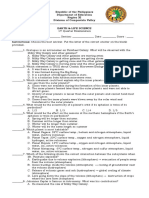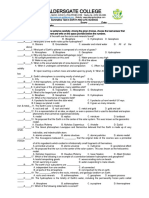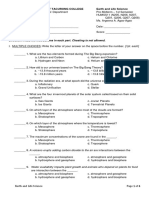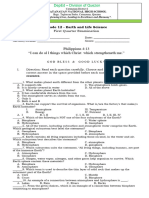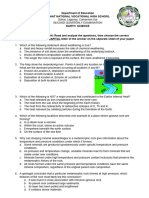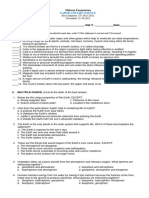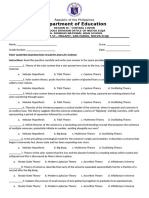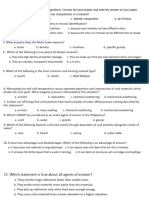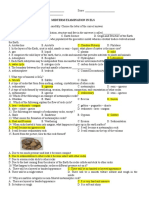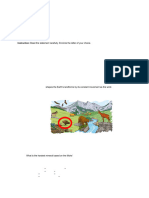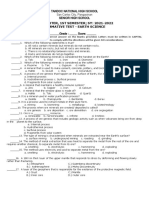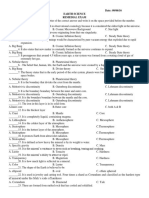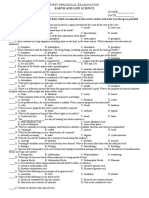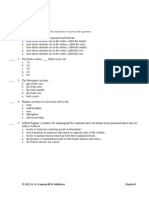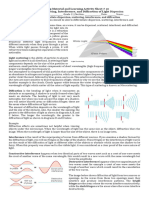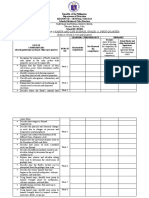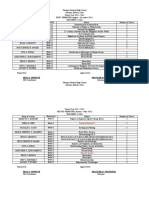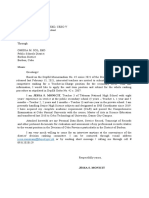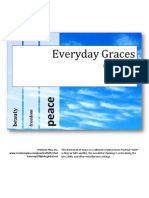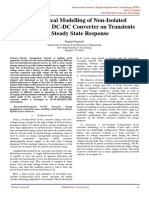0 ratings0% found this document useful (0 votes)
26 viewsST 1
ST 1
Uploaded by
JESSA SUMAYANG1. The document is a summative test in Earth and Life Science covering topics about the unique characteristics and conditions of Earth that enable life, including its distance from the sun, composition and movement of tectonic plates, protective magnetic field and atmosphere.
2. The test contains 30 multiple choice questions about the formation of rocks through igneous, sedimentary and metamorphic processes; weathering and erosion; the composition and layers of Earth's interior; and factors necessary to support life such as water, nutrients and energy from the sun.
3. It requires students to demonstrate their understanding of Earth science concepts about the planet, its geology and environment, and why it is considered a "living planet"
Copyright:
© All Rights Reserved
Available Formats
Download as PDF, TXT or read online from Scribd
ST 1
ST 1
Uploaded by
JESSA SUMAYANG0 ratings0% found this document useful (0 votes)
26 views2 pages1. The document is a summative test in Earth and Life Science covering topics about the unique characteristics and conditions of Earth that enable life, including its distance from the sun, composition and movement of tectonic plates, protective magnetic field and atmosphere.
2. The test contains 30 multiple choice questions about the formation of rocks through igneous, sedimentary and metamorphic processes; weathering and erosion; the composition and layers of Earth's interior; and factors necessary to support life such as water, nutrients and energy from the sun.
3. It requires students to demonstrate their understanding of Earth science concepts about the planet, its geology and environment, and why it is considered a "living planet"
Copyright
© © All Rights Reserved
Available Formats
PDF, TXT or read online from Scribd
Share this document
Did you find this document useful?
Is this content inappropriate?
1. The document is a summative test in Earth and Life Science covering topics about the unique characteristics and conditions of Earth that enable life, including its distance from the sun, composition and movement of tectonic plates, protective magnetic field and atmosphere.
2. The test contains 30 multiple choice questions about the formation of rocks through igneous, sedimentary and metamorphic processes; weathering and erosion; the composition and layers of Earth's interior; and factors necessary to support life such as water, nutrients and energy from the sun.
3. It requires students to demonstrate their understanding of Earth science concepts about the planet, its geology and environment, and why it is considered a "living planet"
Copyright:
© All Rights Reserved
Available Formats
Download as PDF, TXT or read online from Scribd
Download as pdf or txt
0 ratings0% found this document useful (0 votes)
26 views2 pagesST 1
ST 1
Uploaded by
JESSA SUMAYANG1. The document is a summative test in Earth and Life Science covering topics about the unique characteristics and conditions of Earth that enable life, including its distance from the sun, composition and movement of tectonic plates, protective magnetic field and atmosphere.
2. The test contains 30 multiple choice questions about the formation of rocks through igneous, sedimentary and metamorphic processes; weathering and erosion; the composition and layers of Earth's interior; and factors necessary to support life such as water, nutrients and energy from the sun.
3. It requires students to demonstrate their understanding of Earth science concepts about the planet, its geology and environment, and why it is considered a "living planet"
Copyright:
© All Rights Reserved
Available Formats
Download as PDF, TXT or read online from Scribd
Download as pdf or txt
You are on page 1of 2
SUMMATIVE TEST IN EARTH AND LIFE SCIENCE
Quarter 1 Weeks 1 and 2 (September 13 – 24, 2021)
Name of Student: ___________________________________ Grade 11/Section: ___________________ Score: ____
Purok and Address: ___________________________________ Contact Number: ___________________
General Instructions: Please read the questions below thoroughly and write the letter of your
answer on the space before each number.
____1. What is unique about the Earth?
a. The Earth receives too much heat from the Sun.
b. The Earth receives the right amount of heat from the Sun.
c. The Earth receives too much heat during daytime.
d. The Earth receives the right thermal energy from the Sun.
____2. What is unique about the existence of water on Earth?
a. There's too much water to handle.
b. The water has its freezing point in the north and south pole.
c. There's neither too much nor too little water on Earth.
d. The water provides nutrients for the living organisms on Earth.
____3. Earth is protected by ____________, whose gravity helps divert and vacuum up
incoming debris and keep it safe.
a. Saturn b. Neptune c. Mars d. Jupiter
____4. Which prevents the poles from shifting unexpectedly?
a. The moon’s stabilizing effect. c. The moon's revolution around the Earth.
b. The sun's light atmosphere. d. The sun's gravitational pull.
____5. Which factor allows Earth to have a comfortable temperature?
a. plate tectonics b. atmosphere c. energy d. water
____6. It covers the entire Earth and plays an important role in geologic happenings.
a. energy b. plate tectonics c. atmosphere d. water
____7. Earth's surface is composed of how many percent of water?
a. 50% b. 60% c. 70% d. 80%
____8. Nitrogen is considered as the most abundant element in the atmosphere. How
many percent of nitrogen are there in the atmosphere?
a. 71% b.78% c. 74% d. 75%
____9. Earth's plate tectonics are constantly moving around.
a. TRUE b. Somehow c. False d. Maybe
____10. Which of the following trait/s of the Earth is/are necessary in life?
a. atmosphere b. water c. nutrients d. all of these
____11. Why is Earth considered as a "living planet"?
a. It is located near the sun. c. It is a terrestrial planet.
b. It can sustain life. d. It has its own satellite.
____12. Which of the following is/are needed for organisms to live on Earth?
a. energy b. nutrients c. water d. all of these
____13. Which of the following best describes the surface of the planet Earth?
a. It is covered with a thick layer of carbon dioxide.
b. It has a rocky and is covered with sand
c. It is covered with volcanoes.
d. It is covered mostly with water
____14. Earth is said to be a unique planet. Which answer verifies the statement?
a. It supports life. c. It is mostly covered in water.
b. It has a satellite of its own. d. All of the above
____15. Earth's magnetic field shields us from solar wind and helps hold onto atmosphere
and water. Where do these invisible protector come from?
a. Aurora borealis b. plate tectonics c. metal core. d. all of the above
____16. What type of rock is formed through cooling and crystallization of hot, molten rock
material called magma?
a. Sedimentary Rocks b. Metamorphic Rocks c. Igneous Rocks d. bot A and B
____17. Which type of rock is common at the surface of the Earth?
a. Sedimentary Rocks b. Metamorphic Rocks c. Igneous Rocks d. all of these
____18. What are the main factors of the formation of metamorphic rocks?
a. changes in weather b. heat and pressure c. heating of magma d. erosion
____19. Which of the following are the types of sedimentary rocks?
a. Clastic and Nonclastic c. Intrusive and Extrusive
b. Foliated and Nonfoliated d. all of these
____20. How do extrusive igneous rocks differ from intrusive igneous rocks?
a. Extrusive igneous rocks are formed from solidified magma underneath the earth
while intrusive igneous rocks are formed from solidified lava at or near the surface of
the earth.
b. Intrusive rocks have an average range of cooling or crystallization while Intrusive
igneous rocks have fast rate of cooling/ crystallization.
c. Extrusive rocks have slow cooling or crystallization while Intrusive igneous rocks
have fast rate of cooling/ crystallization.
d. Intrusive igneous rocks are formed from solidified magma underneath the earth
while Extrusive igneous rocks are formed from solidified lava at or near the surface of
the earth.
____21. Which of the following is an agent of weathering?
a. water b. animals c. wind d. All of these
____22. What kind of sedimentary rocks are formed from the evaporation of water leaving
the dissolved minerals to crystallize?
a. Precipitates b. Bioclastic c. Evaporates d. clastic
____23. How does clastic sedimentary rock differ from nonclastic sedimentary rock?
a. Clastic sedimentary rocks are commonly classified based on particle size while
Nonclastic Sedimentary rocks are classified based on its origin.
b. Nonclastic sedimentary rocks are commonly classified based on particle size while
Clastic Sedimentary rocks are classified based on its origin.
c. Both A and B are correct
d. None of the two are correct
____24. Which of the following list of rocks belong to foliated metamorphic rock?
a. Marble b. Quartzite c. Dolostone d. schist
____25. Which of the following is an example of igneous rock?
a. Schist b. limestone c. chalk d. gabbro
____26. Halite is formed when seawater evaporates and salt precipitates and is deposited
as crystallized halite. How do you classify this type of rock?
a. Nonclastic b. Foliated c. Intrusive d. Bioclastic
____27. What type of rock is formed when there are too much heating and compression?
a. Igneous rock b. Sedimentary rock c. Metamorphic rock d. All of these
____28. Which of the following refers to the change of rocks' appearance due to heat and
pressure? a. sedimentation b. Weathering c. Erosion d. Metamorphism
____29. Which of the following terms refers to the process of removing Earth materials
from their original sites through weathering and transporting these materials to a new
location? a. sedimentation b. Weathering c. Erosion d. Compaction
____30. What type of rock is produced in mechanical weathering?
a. Clastic Sedimentary Rock c. Foliated Metamorphic Rock
b. Nonclastic Sedimentary Rock d. Non - foliated Metamorphic Rock
Name and Signature of Learner: __________________________________________ Date: _________________
Name and Signature of Parent: ____________________________________________ Date: ________________
Name and Signature of Teacher: JESSA SUMAYANG – MONICIT Date: _________________
You might also like
- Earth and Life Science 1st Quarter Exam DRAFTDocument5 pagesEarth and Life Science 1st Quarter Exam DRAFTBillones Rebalde Marnelle100% (11)
- Earth and Life Science Ist Quarterly Exam.Document2 pagesEarth and Life Science Ist Quarterly Exam.Maestro Pisika Lpt93% (15)
- TOS Earth & Life Science - Mid Term ExamDocument6 pagesTOS Earth & Life Science - Mid Term ExamRosana De Asis75% (4)
- MONICIT - Teachers' LAC Session - CanvaDocument1 pageMONICIT - Teachers' LAC Session - CanvaJESSA SUMAYANGNo ratings yet
- Literature and SocietyDocument28 pagesLiterature and SocietyAyomikun Oluwafemi Idowu100% (1)
- Bambara Manual 2Document156 pagesBambara Manual 2Francisco José Da Silva100% (2)
- 5-Second RuleDocument5 pages5-Second RuleMaria CristinaNo ratings yet
- Summative Test-EALS (1st Quarter)Document3 pagesSummative Test-EALS (1st Quarter)Cassidy Zapanta100% (2)
- PT Earth and Life Science Q1Document5 pagesPT Earth and Life Science Q1Mika Jade BaddalNo ratings yet
- 2021 Summative Test ELSDocument5 pages2021 Summative Test ELSKristian Jay NantaNo ratings yet
- First Monthly Test ELSDocument4 pagesFirst Monthly Test ELSTristan PereyNo ratings yet
- E&l Q1 TQSDocument3 pagesE&l Q1 TQSbless VizcaraNo ratings yet
- Summative TestDocument4 pagesSummative TestJaysonEscatronPaguilaNo ratings yet
- EDITED - Q1 G11 Earth and Life Science SummativeDocument11 pagesEDITED - Q1 G11 Earth and Life Science SummativeTonet Salago CantereNo ratings yet
- Notre Dame of Tacurong College Earth and Life ScienceDocument4 pagesNotre Dame of Tacurong College Earth and Life Scienceargenius23No ratings yet
- Notre Dame of Tacurong College Earth and Life ScienceDocument4 pagesNotre Dame of Tacurong College Earth and Life Scienceargenius23No ratings yet
- Earth Science Prelim Examination QuestionnaireDocument7 pagesEarth Science Prelim Examination QuestionnaireCrisJoy DiuyanNo ratings yet
- Earth and Life - TQDocument5 pagesEarth and Life - TQLouie Jane EleccionNo ratings yet
- Exam MIDTERM 1Document5 pagesExam MIDTERM 1CheckayNo ratings yet
- 1st Quarter Diagnostic Test in ELS 11Document3 pages1st Quarter Diagnostic Test in ELS 11ivyNo ratings yet
- TOS Earth & Life Science - Mid Term ExamDocument7 pagesTOS Earth & Life Science - Mid Term ExamKemberly Semaña Penton100% (3)
- 1st-Periodic-Test-Earth-and-Life-ScienceDocument4 pages1st-Periodic-Test-Earth-and-Life-Sciencepaul.porrasNo ratings yet
- Earth and Life Science ExamDocument4 pagesEarth and Life Science ExamNICOLE ANN GARINNo ratings yet
- Q1, Earth Science SY 2022-2023Document7 pagesQ1, Earth Science SY 2022-2023Jenny Vhie S. Vinagrera100% (1)
- 1st QUARTER EXAM IN EARTH SCIENCEDocument5 pages1st QUARTER EXAM IN EARTH SCIENCENorman James CuyoNo ratings yet
- 1st Quarterly Examination-Earth-and-Life-Science-2022-2023Document7 pages1st Quarterly Examination-Earth-and-Life-Science-2022-2023Maryjul Ramos Ranay100% (4)
- Long Quiz in Earth and Life ScienceDocument2 pagesLong Quiz in Earth and Life ScienceMary Jane BaniquedNo ratings yet
- EARTH AND LIFE SCIENCE II Answer KeyDocument4 pagesEARTH AND LIFE SCIENCE II Answer Keyjelena jorgeoNo ratings yet
- Directions: Choose The Letter of The Correct AnswersDocument2 pagesDirections: Choose The Letter of The Correct AnswersMoris MarfilNo ratings yet
- Earth and Life Science - Quarterly TestDocument7 pagesEarth and Life Science - Quarterly TestPrudevenoNo ratings yet
- Earth Science Final Exam 2024Document7 pagesEarth Science Final Exam 2024JANET SICMATENNo ratings yet
- 1Q - Exam - Earth and Life ScienceDocument3 pages1Q - Exam - Earth and Life ScienceAlexis John Hisula VillahermosaNo ratings yet
- Earth and Life ScienceDocument6 pagesEarth and Life ScienceMailene MagsicoNo ratings yet
- 1st QuarterDocument5 pages1st QuarterlindyNo ratings yet
- Summative Test Week 1 - 4 Earth and Life ScienceDocument2 pagesSummative Test Week 1 - 4 Earth and Life ScienceCherrina AguilaNo ratings yet
- Earth & Life Science Summative TestDocument2 pagesEarth & Life Science Summative TestAriane Ignao Lagatic50% (2)
- Grade 11-Earth ScienceDocument7 pagesGrade 11-Earth ScienceEhdz Torno FernandezNo ratings yet
- Earthscie Q1examDocument5 pagesEarthscie Q1examJeralyn Vallecer-AbelloNo ratings yet
- 1st QE Earth Sci 18-19Document2 pages1st QE Earth Sci 18-19CHRISTINE MAE PASTERNo ratings yet
- Geology 2014: Identify The Choice That Best Completes The Statement or Answers The QuestionDocument18 pagesGeology 2014: Identify The Choice That Best Completes The Statement or Answers The QuestionKavita KrishnamorthiNo ratings yet
- First Periodicals Grade 11Document3 pagesFirst Periodicals Grade 11Salve Gregorio AguirreNo ratings yet
- Earth and Life ScienceDocument7 pagesEarth and Life ScienceRonieNo ratings yet
- 2nd QUARTER EXAM FINALDocument3 pages2nd QUARTER EXAM FINALjuliusvaldez07201996No ratings yet
- Midtermexam E&lDocument4 pagesMidtermexam E&lMARIA CHARMAINE ANDESNo ratings yet
- FIRST QUARTER EXAM in ELSDocument4 pagesFIRST QUARTER EXAM in ELSSuzette De LeonNo ratings yet
- Quiz ELS 2022-2023Document8 pagesQuiz ELS 2022-2023cheryl tayasNo ratings yet
- Alexis G. Santos National High School Summative TestDocument2 pagesAlexis G. Santos National High School Summative TestArjay Nabong100% (1)
- Name: - Score: - Grade & Section: - DateDocument4 pagesName: - Score: - Grade & Section: - DateMichelle Ramirez Co-Gonzales100% (1)
- Fourth Periodical Exam in ScienceDocument4 pagesFourth Periodical Exam in ScienceMonica ManaloNo ratings yet
- ELS&EsP7 - 1st Periodical TestDocument4 pagesELS&EsP7 - 1st Periodical TestCindy ManipolNo ratings yet
- 1st Periodical Test Earth and Life Science 2022-2023Document5 pages1st Periodical Test Earth and Life Science 2022-2023Marfe MontelibanoNo ratings yet
- Els Summative TestDocument6 pagesEls Summative TestLady Ash.100% (1)
- EARTH AND LIFE SCIENCE MID-TERM EXAMDocument5 pagesEARTH AND LIFE SCIENCE MID-TERM EXAMcristina maquintoNo ratings yet
- ESL NAT Reviewer2Document6 pagesESL NAT Reviewer2ABEGAEL ARINDAENGNo ratings yet
- GRADE 11 - EARTH and Life SCIENCEDocument5 pagesGRADE 11 - EARTH and Life SCIENCEZERILLE ANNE INSON AGREGADONo ratings yet
- Earth Science SUMMATIVE TESTDocument2 pagesEarth Science SUMMATIVE TESTEdrian SapiraNo ratings yet
- Remedial Exam EsDocument2 pagesRemedial Exam EsFortin FlorifeNo ratings yet
- 1STQT Exam-Earth&lifeDocument2 pages1STQT Exam-Earth&lifeROXANNE APOSTOLNo ratings yet
- Els 1. Prelim ExamDocument3 pagesEls 1. Prelim Examangelo llenesNo ratings yet
- Chapter 08 PDFDocument8 pagesChapter 08 PDFMarley FelderNo ratings yet
- Earth and Life Science QRT1 Summative 20202021Document4 pagesEarth and Life Science QRT1 Summative 20202021Alexandra Mae Coronel DoblonNo ratings yet
- 1st periodical test earth and life science 2022-2023Document5 pages1st periodical test earth and life science 2022-2023cristina maquintoNo ratings yet
- Midterm Exam-Eals-2022-2023Document4 pagesMidterm Exam-Eals-2022-2023Ricky Boy AtilanoNo ratings yet
- What Makes Earth Soil Different from Mars? - Soil Science for Kids | Children's Earth Sciences BooksFrom EverandWhat Makes Earth Soil Different from Mars? - Soil Science for Kids | Children's Earth Sciences BooksNo ratings yet
- Q4 - Las 10Document2 pagesQ4 - Las 10JESSA SUMAYANGNo ratings yet
- Q4 - Las 8Document2 pagesQ4 - Las 8JESSA SUMAYANGNo ratings yet
- Faculty and Staff Meeting - June 20, 2022Document2 pagesFaculty and Staff Meeting - June 20, 2022JESSA SUMAYANGNo ratings yet
- Q4 - Las 11Document4 pagesQ4 - Las 11JESSA SUMAYANGNo ratings yet
- Q4 - Las 13Document2 pagesQ4 - Las 13JESSA SUMAYANGNo ratings yet
- 101 Amazing Earth FactsDocument9 pages101 Amazing Earth FactsJESSA SUMAYANGNo ratings yet
- Election Accomplishment ReportDocument1 pageElection Accomplishment ReportJESSA SUMAYANGNo ratings yet
- CIM in ELS - Q2Document1 pageCIM in ELS - Q2JESSA SUMAYANGNo ratings yet
- Republic of The Philippines Department of Education: Tabunan National High School Tabunan, Borbon, CebuDocument1 pageRepublic of The Philippines Department of Education: Tabunan National High School Tabunan, Borbon, CebuJESSA SUMAYANGNo ratings yet
- 2022 - 2023 DocumentationDocument4 pages2022 - 2023 DocumentationJESSA SUMAYANGNo ratings yet
- Competency ChecklistDocument3 pagesCompetency ChecklistJESSA SUMAYANGNo ratings yet
- 2022 - 2023 Teachers' LoadingDocument2 pages2022 - 2023 Teachers' LoadingJESSA SUMAYANGNo ratings yet
- PR2 LAS - Quarter 1 - Week 6 - October 18 - 22, 2021Document2 pagesPR2 LAS - Quarter 1 - Week 6 - October 18 - 22, 2021JESSA SUMAYANGNo ratings yet
- PR2 LAS - Quarter 1 - Week 3 - September 27-October 1 2021Document3 pagesPR2 LAS - Quarter 1 - Week 3 - September 27-October 1 2021JESSA SUMAYANGNo ratings yet
- Application LettersDocument2 pagesApplication LettersJESSA SUMAYANGNo ratings yet
- PR2 LAS - Quarter 1 - Week 5 - October 11 - 15, 2021Document2 pagesPR2 LAS - Quarter 1 - Week 5 - October 11 - 15, 2021JESSA SUMAYANG100% (1)
- ST 3Document2 pagesST 3JESSA SUMAYANGNo ratings yet
- PR2 LAS - Quarter 1 - Week 3 - September 27-October 1 2021Document3 pagesPR2 LAS - Quarter 1 - Week 3 - September 27-October 1 2021JESSA SUMAYANGNo ratings yet
- Corresponds To The Correct Answer. Write You Answers On The Space Before Each NumberDocument2 pagesCorresponds To The Correct Answer. Write You Answers On The Space Before Each NumberJESSA SUMAYANGNo ratings yet
- Christmas Party TarpDocument1 pageChristmas Party TarpJESSA SUMAYANGNo ratings yet
- pr2 Cover 7Document1 pagepr2 Cover 7JESSA SUMAYANGNo ratings yet
- Group 3Document91 pagesGroup 3Anny YanongNo ratings yet
- Everyday Graces: by Katherine Murray © 2009Document30 pagesEveryday Graces: by Katherine Murray © 2009Katherine MurrayNo ratings yet
- User's Guide: Sw-161 SmartwatchDocument174 pagesUser's Guide: Sw-161 SmartwatchȚuluca AureliaNo ratings yet
- © Ncert Not To Be Republished: Organisation of DataDocument18 pages© Ncert Not To Be Republished: Organisation of DataVysakh SreenivasanNo ratings yet
- 5s Basic TrainingDocument15 pages5s Basic TrainingMaja BookmarksNo ratings yet
- SCM Unit 5Document24 pagesSCM Unit 5AMAN VERMANo ratings yet
- The Waking of Willowby Hall - ShadowdarkDocument2 pagesThe Waking of Willowby Hall - ShadowdarkJunk EmailNo ratings yet
- Division of LongevityDocument5 pagesDivision of Longevityshree_laxminarayan9No ratings yet
- Public Interest Litigation - A Boon or A Bane by Abhipasha MohantyDocument15 pagesPublic Interest Litigation - A Boon or A Bane by Abhipasha MohantyLatest Laws Team100% (1)
- All-Seeing Eye v2 n2 Dec 1923Document45 pagesAll-Seeing Eye v2 n2 Dec 1923John Compton100% (1)
- NykkaDocument2 pagesNykkaDimitra Taslim100% (1)
- QASAS-UN-NABIYEEN VOLUME 4 قصص النبيين الجلد الرابع PDFDocument77 pagesQASAS-UN-NABIYEEN VOLUME 4 قصص النبيين الجلد الرابع PDFriyaz100% (1)
- AS经济学讲义Document212 pagesAS经济学讲义kevinNo ratings yet
- WHERE Is Giving DirectionsDocument1 pageWHERE Is Giving DirectionsAina19191No ratings yet
- Mathematical Modelling of Non Isolated Bi Directional DC DC Converter On Transients and Steady State Response IJERTCONV3IS20053Document5 pagesMathematical Modelling of Non Isolated Bi Directional DC DC Converter On Transients and Steady State Response IJERTCONV3IS20053CHHEDI LAL MishraNo ratings yet
- Africa Solar Projects Intelligence Track Till 2030Document9 pagesAfrica Solar Projects Intelligence Track Till 2030Paras SachanNo ratings yet
- Fernandez Vs Dela RosaDocument7 pagesFernandez Vs Dela Rosagilbert213100% (1)
- Trabajo Semana 45 PH03Document195 pagesTrabajo Semana 45 PH03Derlis Diego Yaringaño PerezNo ratings yet
- Admin Law Meaning, Nature, ScopeDocument22 pagesAdmin Law Meaning, Nature, ScopeScheherazade SandhuNo ratings yet
- Compare and Contrast The Italian and German UnificationsDocument4 pagesCompare and Contrast The Italian and German UnificationsEmre KayaogluNo ratings yet
- Module 3Document9 pagesModule 3Jay BaliarNo ratings yet
- Analytical AssignmentDocument23 pagesAnalytical AssignmentTashey ChhodyenNo ratings yet
- Petition Probate WillDocument4 pagesPetition Probate WillPaulo Villarin0% (1)
- Leger's North American TrackerDocument34 pagesLeger's North American TrackerNew York PostNo ratings yet
- Adobe Scan Nov 10, 2023Document15 pagesAdobe Scan Nov 10, 2023MANDA SIMRITANo ratings yet
- Manual FPX PDFDocument584 pagesManual FPX PDFCyber PhoenixNo ratings yet
- Reporting Verbs Exercise 1Document3 pagesReporting Verbs Exercise 1Regina Santos0% (2)
